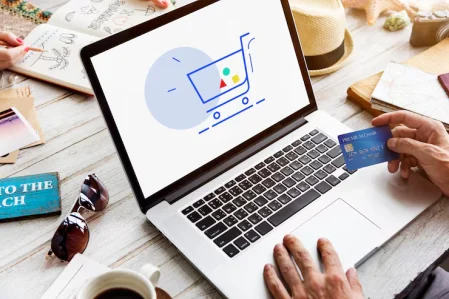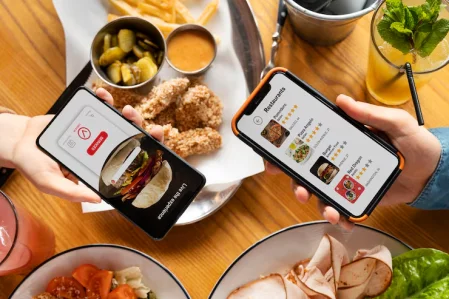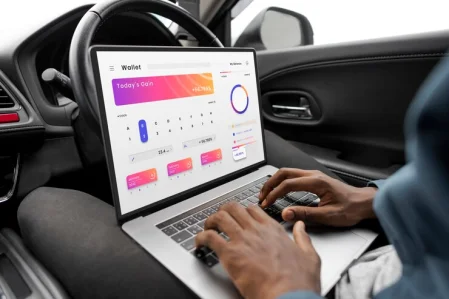Shopping is no longer confined to stores or even websites; apps have become the quickest way for people to browse, compare, and purchase items within seconds. Whether it’s fashion, groceries, or electronics, customers today have come to expect an eCommerce app that is fast, easy to use, and secure.
For businesses, this is a huge opportunity: creating an e-commerce app that not only gets users in but keeps them mindful. But having a high-performing app is about more than adding a product catalog and checkout button. It’s about piecing together the right elements of design and technology to create a frictionless consumer experience.
This guide will show you exactly how to build an e-commerce app from scratch, including design methodology, technology stack, essential features, cost drivers, and professional tips to ensure your app succeeds in a crowded market. Let’s get started:
What Is An E-Commerce App?
An e-commerce app is a software application (web or mobile) that enables businesses and consumers to buy and sell products or services online. It provides features such as product browsing, secure payment processing, order tracking, and customer support, making digital transactions fast, convenient, and accessible.
Such applications could be interpreted in two ways:
- Variations of Digital Transactions – Various online activities fall under the category of e-commerce apps, such as retail shopping, subscription services, digital downloads, and virtual consultation. And that highlights how wide the reach of e-commerce really is.
- The systems themselves – This can mean the e-commerce software that processes online transactions. Examples are well-known trades, such as Amazon, eBay, and Alibaba, that can be accessed through a webpage or portable terminals. Due to the increased use of smartphones, mobile-friendly features (m-commerce) are an important aspect of modern e-commerce.
Fundamentally, e-commerce applications all have a base feature set in common:
- Shopping carts for managing products,
- Real-time secure payment gateways for online orders, &
- CRM digitization for better customer engagement.
Taken together, these capabilities enable not just the sale of merchandise, but also adaptation to shifts in consumer behavior and technological trends.
E-commerce apps have grown stronger with developments such as AI. Significantly, today, thanks to AI-based tools for personalizing shopping experiences (for making personalized product recommendations, delivering optimized marketing campaigns, and automating customer support), businesses leveraging an e-commerce app development service have been able to unravel how to succeed in today’s rapidly moving digital age.
Steps To Build An E-Commerce Application
Creating a profitable eCommerce App is not only about writing code, rather it’s more about aligning business strategies with technical execution. Every little thing counts, from understanding your audience to smooth checkout.

Here is a malleable step-by-step guide for you to follow while you build an eCommerce app:
1. Market Research & Strategic Planning
The journey begins with research. Figure out who your audience is, research competition, and understand customer pain points. This step helps you decide:
What your app needs to do
- How to differentiate yourself from competitors
- The business model (B2B, B2C, marketplace, subscription, and so on)
A clear strategy to ensure your app is not just functional, but that it answers a direct market need.
2. First Outline Core Features & User Needs
Once you know your market, it’s time to map the features. Successful eCommerce apps usually include:
- User Sign-Up / Login (EmailOrPhoneNumber, SocialLogins or MobileOTP)
- Product Catalog & Categories
- Search & Filters for easy product finding
- Cart & Wishlist
- Payment Gateway Integration (cards, wallets, BNPL, UPI, etc.)
- Order Tracking & Notifications
- Support (chatbot versus live support)
Begin with a Minimum Viable Product (MVP) — a pared-down version with the few features that matter most — and grow features as feedback comes in from users.
3. Design a Seamless UI/UX
When you are designing a marketplace app, UI/UX makes the difference when it comes to the way your users use your platform. If you work with an app development company, their Business Analyst team would prepare wireframes and mockups to showcase the structure of the app. The wireframe was finalised, and UI/UX designers began designing an intuitive interface, using App Store and Play Store guidelines. You can trust expert designers to put your brand identity into everything; logos, fonts, colors, to product images, so that everything works consistently. For example, our communication team developed a crisp responsive interface for a Somaliland-based online bookstore (Sahanbooks), which maximised user navigation and engagement.
In contrast, if you use e-commerce website builders or SaaS platforms, then the process of designing the site will include things like choosing a theme, categorizing products, and modifying templates to match your business. Convenience aside, the fact is that when it comes to achieving the perfect look, which is both easy on the eye and easily navigable, there’s no substitute for a customised theme. Whether you are building from scratch or a SaaS-based builder, a well-designed marketplace app will allow users to find, browse, and purchase easily anywhere and on any screen size. When you invest in good User Experience design, you aren’t just making your app pleasing to the eye—you’re crafting a shopping journey that’s so easy, you’ll keep customers coming back for more.
A good UI/UX should:
- Look good and match your brand
- Provide easy browsing with scant clicks to the order process
- Be mobile optimized for all screen sizes
- Leverage transparent call-to-actions (CTAs) such as “Buy This” or “Add to Cart”
- A good design is not just beautiful; it converts.
4. Build out the App (Frontend & Backend)
The development phase is the most crucial stage of an e-commerce mobile app project. After design and UI/UX have been planned out and solidified, the best part starts. Here’s where your mobile app developers get to work, writing code, creating the architecture, and incorporating anything else they need to help the thing run in a seamless way for users on iOS, Android, and cross-platform situations.
Coding has to do with both the frontend (what the users interact with) and the backend (the engine that works behind the scenes). Developers also link to third-party APIs, build databases, integrate payment processing, and introduce advanced features such as product search, recommendations, or live order tracking.
Your app is built on programming languages like Kotlin, Swift, Java, Flutter, or React Native – languages that allow your dev team to make sure your app is scalable, high-performing and secure.
5. Test for Quality & Performance
Once your eCommerce mobile app is built, testing becomes one of the most important steps. Proper testing makes sure your app runs smoothly, is easy to use, secure, and performs well on all devices before it goes live. Even a beautifully designed app can fail if it has glitches or doesn’t meet user expectations. Careful testing not only fixes problems but also builds trust with your customers.
Why Testing Matters in eCommerce App Development
- Catch and Fix Bugs Early: Testing helps identify issues before customers experience them, preventing frustration.
- Optimize Performance: It ensures every feature—from browsing products to completing checkout—works perfectly.
- Build Customer Trust: A secure and reliable app encourages users to keep coming back.
- Protect Your Reputation: Avoid glitches that could lead to negative reviews or app uninstalls.
Key Types of Testing for eCommerce Apps
- Functional Testing: Makes sure all features like product search, filters, shopping cart, and payments work exactly as they should.
- Usability Testing: Checks how easy and intuitive the app is for users, ensuring smooth navigation and a positive experience.
- Performance Testing: Measures how the app handles different conditions, like high traffic or slow network speeds, to avoid lag or crashes.
- Security Testing: Protects sensitive customer information, including payment details, by identifying vulnerabilities and preventing breaches.
- Compatibility Testing: Ensures the app works well across devices, operating systems, and screen sizes, giving all users a consistent experience.
- Regression Testing: Verifies that updates or new features don’t break existing functionality, keeping the app stable.
- Load and Stress Testing: Simulates heavy usage to see how the app performs under pressure, ensuring it can handle peak shopping times.
- Localization Testing (if applicable): For apps serving multiple regions, this makes sure language, currency, date formats, and regional regulations are correct.
Thorough testing makes your eCommerce app reliable, secure, and enjoyable to use. It improves customer satisfaction, encourages repeat business, and strengthens your brand’s reputation.
6. Launch the App
After all the work you’ve done to develop the app, now it’s time to release it on the Google Play Store and Apple App Store. Prepare:
- Marketing campaigns and pre-launch buzz
- App Store Optimization (ASO) for discoverability
- Early user questions and feedback support team
The launch is so critical as it can shape the success of the downloads and the user adoption.
7. Post-Launch Monitoring & Continuous Updates
It also could not be a launch merely. An effective eCommerce app changes according to:
- User feedback (reviews, complaints, suggestions)
- Performance analytics (how much you are converting, bouncing, and retaining)
- Development of new features to be ahead of the competition
Regular updates fix bugs, enhance the speed, and introduce more features to keep your audience engaged.
Types Of E-Commerce Applications
Before jumping into development, you need to first think about which type of e-commerce app makes sense for your business model. Each has a different audience and offers unique features, so selecting the right one sets the tone for your growth strategy.
1. B2B (Business-to-Business) E-Commerce Apps
In this approach, businesses would offer products or services to other businesses rather than directly sell to consumers. They tend to be raw materials, supplies, or tools for another company’s operations. For instance, a vendor might sell packaging materials to a retail brand on a B2B app. Some notable examples are Alibaba, IndiaMART, and Amazon Business.
2. B2C (Business-to-Consumer) E-Commerce Apps
The most well-known model, b2c apps, links businesses directly to end-users. Here, buyers purchase goods or services directly from the company, speeding up all transactions. Myntra, Domino’s, and Amazon are a few of the best examples of B2C e-commerce. If what you want to do is to attract a mass audience, that is the model you should be thinking about.
3. C2C (Consumer-to-Consumer) E-Commerce Apps
C2C leverages individuals trading with one another and relies on a trusted marketplace. Typically, these apps operate as third-party platforms where sellers post items for sale and buyers buy them, often with functions such as bidding, auctions, or classified ads. Think OLX, eBay, or Facebook Marketplace—all successful examples of the C2C model.
4. C2B (Consumer-to-Business) E-Commerce Apps
In this nontraditional yet emerging approach, people sell their goods and services to companies. A freelance designer who sells logos to companies using an app, or a photographer who licenses stock images to a brand. That’s the C2B model as seen through the equities of something like Fiverr, Upwork, and Shutterstock.
Also Read: Ecommerce Business Ideas in 2025
Features To Include In An E-Commerce Application
When it comes to establishing a lucrative e-commerce app, features count indeed as much as product range and price are concerned. A good app doesn’t just draw eyeballs, it holds them, draws them in to shop, and keeps them coming back. Here are the indispensable ideas that make an e-commerce app successful:
- Audio-Enhanced Shopping Experience
Shopping used to be visual; now it’s becoming immersive. A growing number of headline apps are incorporating audio to make their interactions richer and more personal. For instance, apps are enabling users to upload short audio clips, share voice reviews, or listen to branded podcasts in the app. This not only increases engagement but also forms a more complete brand authenticity. Anticipate more voice-driven commerce in an age when customers want more humanized shopping experiences.
- Connected TV (CTV) Advertising
As privacy-first marketing becomes the de facto practice (special thanks to Apple’s iOS 14.5 update and Google’s cookie phase-out), brands are turning to Connected TV advertising (CTV). This means that they can now serve targeted, data-driven ads on smart TVs as well as streaming platforms for e-commerce apps.
For businesses, CTV advertising presents an additional, scalable method for reaching connected audiences outside of traditional digital ads, something that is becoming increasingly important as more and more households cut the cord and shift to streaming services.
- Buy now, pay later (BNPL) services
Shoppers are seeking choice, and Buy Now, Pay Later (BNPL) is delivering. Instead of forking over the entire cost up front, consumers can split big purchases into smaller, easy payments, often with no interest. Titans like Apple Pay Later are already establishing the benchmark here.
The BNPL market is projected to add more than $450 billion in growth by 2026, and companies with the offering are achieving higher average order values and better customer retention compared to those depending on credit card use alone.
- Headless Commerce
For companies to remain competitive in the ever-changing world of e-commerce, digital flexibility is a must. This is exactly where headless commerce comes into play. Rather than tightly integrating the frontend (what users see) and the backend (where everything happens), this method separates them, leading to easier integrations and faster updates.
Recent reports corroborate the trend: over $1.65 billion has been invested in headless technologies in the past two years alone, so it’s clear the market is shifting heavily in that direction.
Through APIs that link the frontend, backend, and third-party applications, headless commerce enables real-time data to move across channels. That will allow you to control multiple platforms, such as mobile apps, websites, or even smart appliances, without creating completely different systems.
Cost Of Building An E-Commerce App
Developing an eCommerce app will cost you anywhere from $30,000 to $250,000+ (final cost depends on these factors: feature set, technology stack, design complexity, software development methodology, team of developers’ expertise, and long-term scalability). The MVP of an app on the leaner side literally costs at the lower end, compared to an enterprise-grade feature-rich app packed in with advanced integrations and features.
If you are working to get a rough, back-of-the-napkin estimate, here is a simple way to figure it:
Cost Estimate = Total Dev Hours × Hourly Dev Rate
This simple formula provides insights into how the size of the app you want to create and the location of the developers impact the big picture budget.
But beyond the formula, it’s a must to understand how costs are spread out across various phases of app creation. Here’s an approximate phase-wise breakdown:
| S.No | Phase | Timeline | Estimated Cost |
| 1 | Research & Planning | 2–4 weeks | $2,000 – $10,000 |
| 2 | UI/UX Design | 4–6 weeks | $5,000 – $20,000 |
| 3 | App Development | 8–20+ weeks | $20,000 – $150,000+ |
| 4 | Quality Assurance & Testing | 2–4 weeks | $5,000 – $30,000 |
| 5 | Deployment | 1–2 weeks | $3,000 – $15,000 |
| 6 | Ongoing Support & Maintenance | Monthly | $1,000 – $10,000/month |
These figures are indicative numbers and are not fixed. The kind of eCommerce application you are going to develop is also a significant factor that affects the budget.
For example, a simple single-vendor retail app is going to be much easier (and less costly) to build than a multi-vendor marketplace app, or a subscription-based version of an eCommerce app. Equally, adding innovative features such as AR-powered tries on, AI-based recommendations, or advanced payment integrations can drive up the cost of development significantly.
Conclusion
Creating an e-commerce app that works is no longer a matter of putting products online—it’s about creating intuitive, personalized shopping experiences, and offering users innovative ways of purchasing that they haven’t even thought of (yet). From Sephora's AI-enhanced beauty journeys and Warby Parker's AR try-ons to H&M's omnichannel unification and Walmart's convenience-optimized innovations, it’s clear that when it comes to the best global apps, tech and customer-focused design aren’t mutually exclusive.
The lesson for businesses is clear: If you are determined to flourish in the hard-fought digital economy, your obsession should be striking the right balance between usability, innovation, and trust.


 Healthcare App Development Services
Healthcare App Development Services
 Real Estate Web Development Services
Real Estate Web Development Services
 E-Commerce App Development Services
E-Commerce App Development Services E-Commerce Web Development Services
E-Commerce Web Development Services Blockchain E-commerce Development Company
Blockchain E-commerce Development Company
 Fintech App Development Services
Fintech App Development Services Fintech Web Development
Fintech Web Development Blockchain Fintech Development Company
Blockchain Fintech Development Company
 E-Learning App Development Services
E-Learning App Development Services
 Restaurant App Development Company
Restaurant App Development Company
 Mobile Game Development Company
Mobile Game Development Company
 Travel App Development Company
Travel App Development Company
 Automotive Web Design
Automotive Web Design
 AI Traffic Management System
AI Traffic Management System
 AI Inventory Management Software
AI Inventory Management Software
 AI Software Development
AI Software Development  AI Development Company
AI Development Company  AI App Development Services
AI App Development Services  ChatGPT integration services
ChatGPT integration services  AI Integration Services
AI Integration Services  Generative AI Development Services
Generative AI Development Services  Natural Language Processing Company
Natural Language Processing Company Machine Learning Development
Machine Learning Development  Machine learning consulting services
Machine learning consulting services  Blockchain Development
Blockchain Development  Blockchain Software Development
Blockchain Software Development  Smart Contract Development Company
Smart Contract Development Company  NFT Marketplace Development Services
NFT Marketplace Development Services  Asset Tokenization Company
Asset Tokenization Company DeFi Wallet Development Company
DeFi Wallet Development Company Mobile App Development
Mobile App Development  IOS App Development
IOS App Development  Android App Development
Android App Development  Cross-Platform App Development
Cross-Platform App Development  Augmented Reality (AR) App Development
Augmented Reality (AR) App Development  Virtual Reality (VR) App Development
Virtual Reality (VR) App Development  Web App Development
Web App Development  SaaS App Development
SaaS App Development Flutter
Flutter  React Native
React Native  Swift (IOS)
Swift (IOS)  Kotlin (Android)
Kotlin (Android)  Mean Stack Development
Mean Stack Development  AngularJS Development
AngularJS Development  MongoDB Development
MongoDB Development  Nodejs Development
Nodejs Development  Database Development
Database Development Ruby on Rails Development
Ruby on Rails Development Expressjs Development
Expressjs Development  Full Stack Development
Full Stack Development  Web Development Services
Web Development Services  Laravel Development
Laravel Development  LAMP Development
LAMP Development  Custom PHP Development
Custom PHP Development  .Net Development
.Net Development  User Experience Design Services
User Experience Design Services  User Interface Design Services
User Interface Design Services  Automated Testing
Automated Testing  Manual Testing
Manual Testing  Digital Marketing Services
Digital Marketing Services 
 Ride-Sharing And Taxi Services
Ride-Sharing And Taxi Services Food Delivery Services
Food Delivery Services Grocery Delivery Services
Grocery Delivery Services Transportation And Logistics
Transportation And Logistics Car Wash App
Car Wash App Home Services App
Home Services App ERP Development Services
ERP Development Services CMS Development Services
CMS Development Services LMS Development
LMS Development CRM Development
CRM Development DevOps Development Services
DevOps Development Services AI Business Solutions
AI Business Solutions AI Cloud Solutions
AI Cloud Solutions AI Chatbot Development
AI Chatbot Development API Development
API Development Blockchain Product Development
Blockchain Product Development Cryptocurrency Wallet Development
Cryptocurrency Wallet Development About Talentelgia
About Talentelgia  Our Team
Our Team  Our Culture
Our Culture 
 Healthcare App Development Services
Healthcare App Development Services Real Estate Web Development Services
Real Estate Web Development Services E-Commerce App Development Services
E-Commerce App Development Services E-Commerce Web Development Services
E-Commerce Web Development Services Blockchain E-commerce
Development Company
Blockchain E-commerce
Development Company Fintech App Development Services
Fintech App Development Services Finance Web Development
Finance Web Development Blockchain Fintech
Development Company
Blockchain Fintech
Development Company E-Learning App Development Services
E-Learning App Development Services Restaurant App Development Company
Restaurant App Development Company Mobile Game Development Company
Mobile Game Development Company Travel App Development Company
Travel App Development Company Automotive Web Design
Automotive Web Design AI Traffic Management System
AI Traffic Management System AI Inventory Management Software
AI Inventory Management Software AI Software Development
AI Software Development AI Development Company
AI Development Company ChatGPT integration services
ChatGPT integration services AI Integration Services
AI Integration Services Machine Learning Development
Machine Learning Development Machine learning consulting services
Machine learning consulting services Blockchain Development
Blockchain Development Blockchain Software Development
Blockchain Software Development Smart contract development company
Smart contract development company NFT marketplace development services
NFT marketplace development services IOS App Development
IOS App Development Android App Development
Android App Development Cross-Platform App Development
Cross-Platform App Development Augmented Reality (AR) App
Development
Augmented Reality (AR) App
Development Virtual Reality (VR) App Development
Virtual Reality (VR) App Development Web App Development
Web App Development Flutter
Flutter React
Native
React
Native Swift
(IOS)
Swift
(IOS) Kotlin (Android)
Kotlin (Android) MEAN Stack Development
MEAN Stack Development AngularJS Development
AngularJS Development MongoDB Development
MongoDB Development Nodejs Development
Nodejs Development Database development services
Database development services Ruby on Rails Development services
Ruby on Rails Development services Expressjs Development
Expressjs Development Full Stack Development
Full Stack Development Web Development Services
Web Development Services Laravel Development
Laravel Development LAMP
Development
LAMP
Development Custom PHP Development
Custom PHP Development User Experience Design Services
User Experience Design Services User Interface Design Services
User Interface Design Services Automated Testing
Automated Testing Manual
Testing
Manual
Testing About Talentelgia
About Talentelgia Our Team
Our Team Our Culture
Our Culture

















 Write us on:
Write us on:  Business queries:
Business queries:  HR:
HR: 




